Artists' Writing
Artists' Writing

Master Rock
Master Rock is a repertoire for a mountain.
Rough land, open palm. Bodies are machines that shake. Big boned faces, big hands, big claws, ah Jesus, well-used. Bore. Blast. Smash. Force on loan. Must be hard and clever to survive in this technological age. Granite knows the biological. Gods inside the mountain, just plain men outside.
Working through the cavernous space in Ben Cruachan, the largest peak on the west coast of Scotland, Maria Fusco exhumes three fictional voices from fact: Tunnel tigers, the Irish explosives experts who emptied out the mountain to build a power station; Elizabeth Falconer, the artist who produced a mural inside that only the site’s workers ever see; and Granite, the 450 million year-old rock of Cruachan itself as a main character.

Queer Direct
Queerdirect is an LGBTQI+ Artist support network, curatorial platform and arts programme. Initiated by Gaby Sahhar in 2017. Co-run With Lily Cheetah. Queerdirect hold regular events and curate exhibitions around London and provide queer artists with a platform and support. Queerdirect is the UK’s first contemporary arts platform and project space dedicated to queer arts.
This is the first edition, September 2019.
A5 perfect bound publication, 81 pp., published by Queerdirect & Camp Books and featuring 31 LGBTQIA+ artists working in and around London.
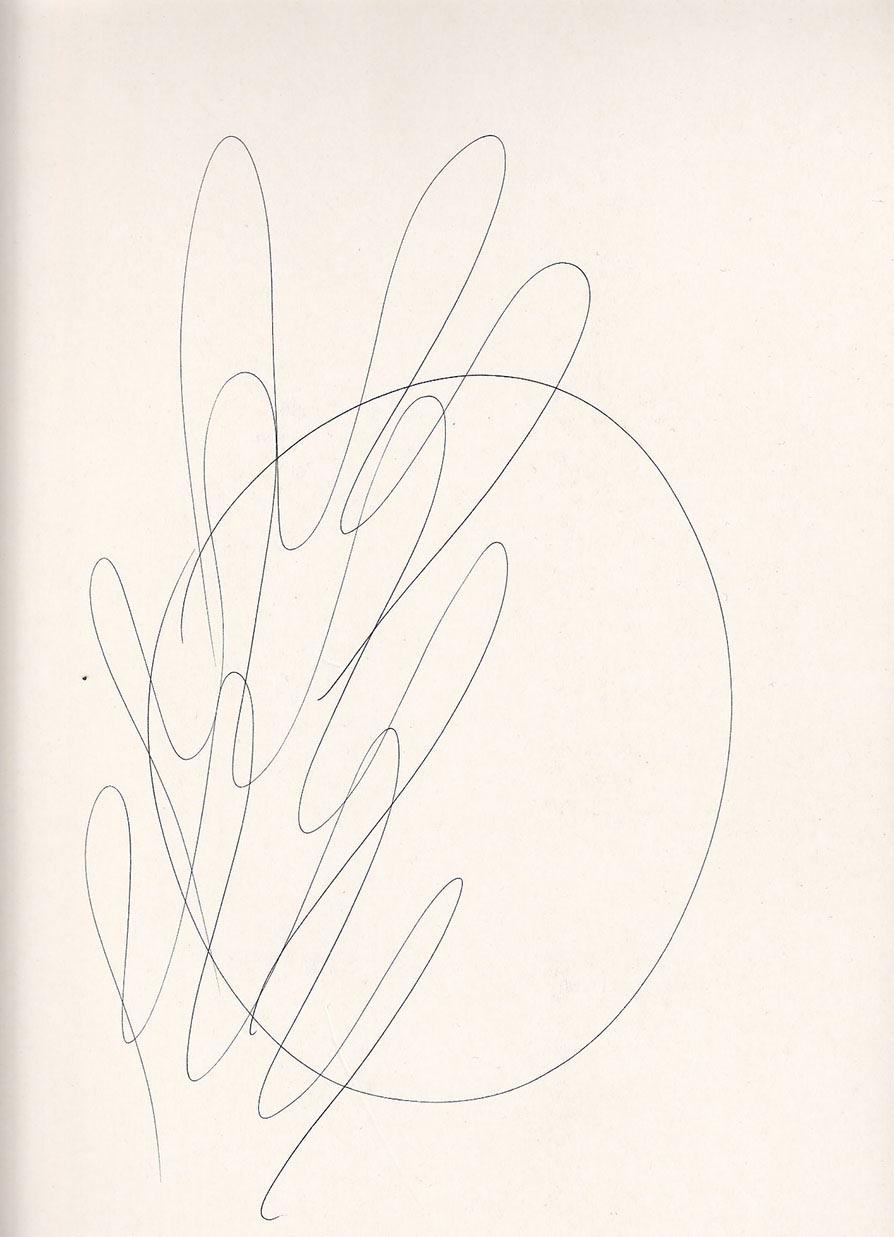
Hand Reading Studies
For 'A Studio in Hand-Reading: Charlotte Wolff' Valentina Desideri transformed Kunstverein’s space into a Studio – a place that generates knowledge through different modes of being together. Throughout the exhibition, Desideri invited participants as well as visitors to gather for readings and in study.
The Studio – and its bar – were open for readings during Kunstverein’s regular opening hours and punctuated by weekly contributions to the study by the invited guests and artists. 'Handreading Studies' picks up where the project left off, bringing together a variety of materials and publications that were generated in or reverberated from the Studio.

Enn Gramaten
Luke Williams, Natasha Soobramanien
A cautionary tale of academic privilege and misadventure in Diego Garcia via a Kreole translation, and parallel live chat.
Dialecty, conceived by Maria Fusco with The Common Guild, considers the uses of vernacular forms of speech and writing, exploring how dialect words, grammar and syntax challenge and improve traditional orthodoxies of critical writing.

Silver Bandage
The Happy Hypocrite – Silver Bandage gathers together new kinds of writing about ‘vibes’, those often unspoken energies of desire and aversion that move between people, palpable but traceless, hard to prove. The messages sent by your gut that you can’t always interpret, beyond an urge. What is intangible – vibes, feelings and reflexive responses like blushes, fidgets, slumps in posture, fluctuations in voice – is now targeted by invasive technologies of affective measurement. How can writing resist this regime of quantification?
With an introduction by Maria Fusco, contributions and new work by CAConrad, Mel Y. Chen, Adam Gallagher, Alexandrina Hemsley, Rebecca Jagoe, Jessa Mockridge, Natasha Papadopoulou, Naomi Pearce, Parsa Sanjana Sajid, Patrick Staff, Daniella Valz Gen, and Hypatia Vourloumis. This issue’s archive is dedicated to Katerina Gogou.
Erica Scourti is an artist and writer, born in Athens and now based mostly in London, whose work explores biographical writing and bodily inscription in the performance of subjectivity. Her writing has been published in Spells, Ignota (2018) and Fiction as Method, Sternberg (2017), among others.

Treatment
Operating on the peripheries of a pathological discourse, Treatment penetrates the interstices of modern queer consciousness to medicate a multiheaded body of work. With no cure in sight, the text moves from violence, cowboys, iconography, illness and image to the death of Yves Klein and a fear of dentistry. Bridget’s reflections pose a dissection of novelistic cliché that attends to the repressed remnants of a queer romance. Played out in an interpersonal run of vignettes or “treatments,” rather than any death of the novel Treatmentpropositions a mischievous and travestying performance anchored in putrefaction. A serious play with the decay of forms, Treatment is a rendered reading of our ability to talk through the process of degradation and an ironized analysis of the desire to write it down.
In Bridget’s “mouth-theatre” sit Allan and Allen—two precarious, spectral characters set against an eerie backdrop of clinical isolation. Framed by a nameless narrator, these mirrored figures undergo forty text-treatments across four artificially generated days that survey their feelings of angst, adulation and disorientation against the slow tick of a clock. A mash-up of love story, pornography, art criticism, literary appropriation, and essayistic meditation, Treatment pushes an anatomical body to its limits in a parodic portrayal of a mouth on the hunt for a tongue and its teeth.

A Family in Brussels
Filmmaker Chantal Akerman presents A Family in Brussels, a fictional stream-of-consciousness text encompassing multiple subjectivities and laced with autobiographical references. This is the first English-language publication of the work, which Akerman wrote and first performed as a monologue in Paris and Brussels. The accompanying recording documents the theatrical reading that took place at the Dia Center for the Arts, New York, in October 2001. The listener can hear Akerman's singular voice as she muses on familial relations, communication, closeness, and distance.
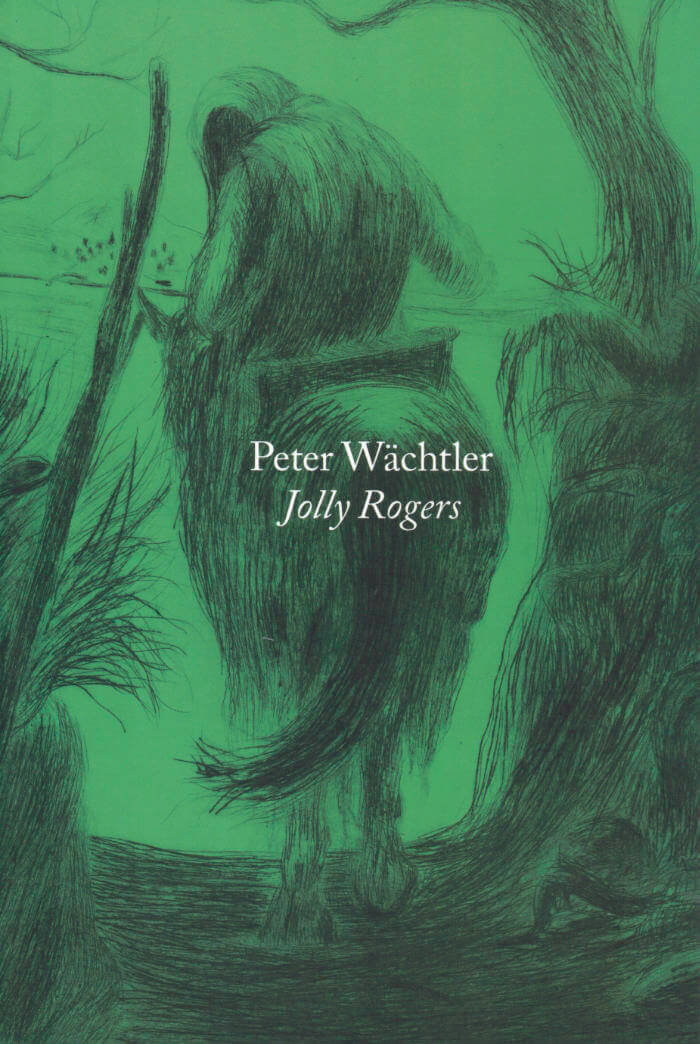
Jolly Rogers
Jolly Rogers is a collection of Peter Wächtler's latest short texts, written in preparation of his two solo exhibitions at Bergen Kunsthall and Kunsthalle Zürich (both 2019), and combined with a nearly complete collection of the artist's drawings and prints from recent years.
The texts operate like vignettes to a larger story, and the images as unreliable illustrations to the narrative. However, the larger story never really is revealed. Each individual text, each single work, articulates itself by means of an intense focus. It is as if we were suspended in a continual zooming motion, as if the artist and author wanted to tell and show it all. But alas, such is life under the microscope: always larger-than-life, but at the wrong scale at a time driven by individual interests, self-optimization, and egos that stage themselves simultaneously as victims and disruptors.
Peter Wächtler works in a variety of media: bronze, ceramics, drawings and video. But in many ways “stories” could be described as his main artistic material. His works often evoke a narration, with animals or human figures in animated states. They are made in ways that use and adapt elements of fiction and folklore, relating to specific traditions and common tales, and materialize the ways of telling a story as much as the story itself.
Born 1979 in Hannover, Peter Wächtler lives and works in Brussels and Berlin.
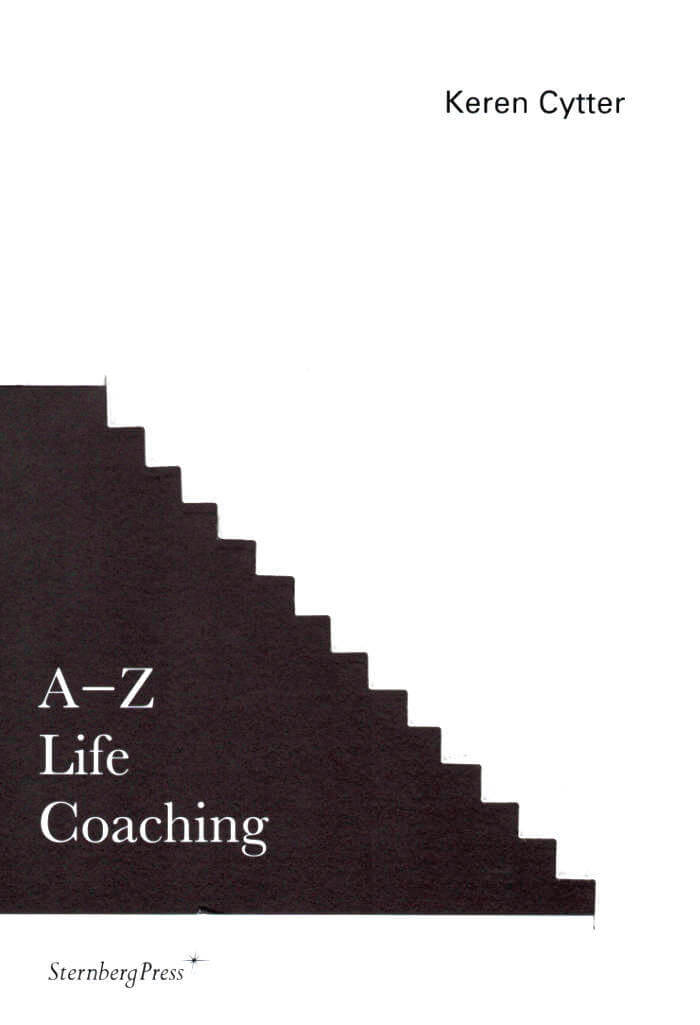
A-Z Life Coaching
A novel by Keren Cytter: an incomplete guide for life.
Each person written about is represented by a letter, and when an object turns into a subject it is marked in bold. The form of life coaching described in this book won't lead the reader to social recognition or financial success. If one of the two occurs after reading this text, it is a coincidence. This book aims to expose the owners of an innocent heart to reality's true structures and to utilize them for spiritual growth so their soul and body evaporate into the abstract. This book was written from the middle. The contents of these pages have been modified numerous times. Notes were taken, ideas were rewritten—the ones that survived bare the most essential guidelines and wisdom for life.
Published on the occasion of the exhibition “Keren Cytter – Selection”, Künstlerhaus, Halle für Kunst & Medien, Graz, from June 11 to September 8, 2016.
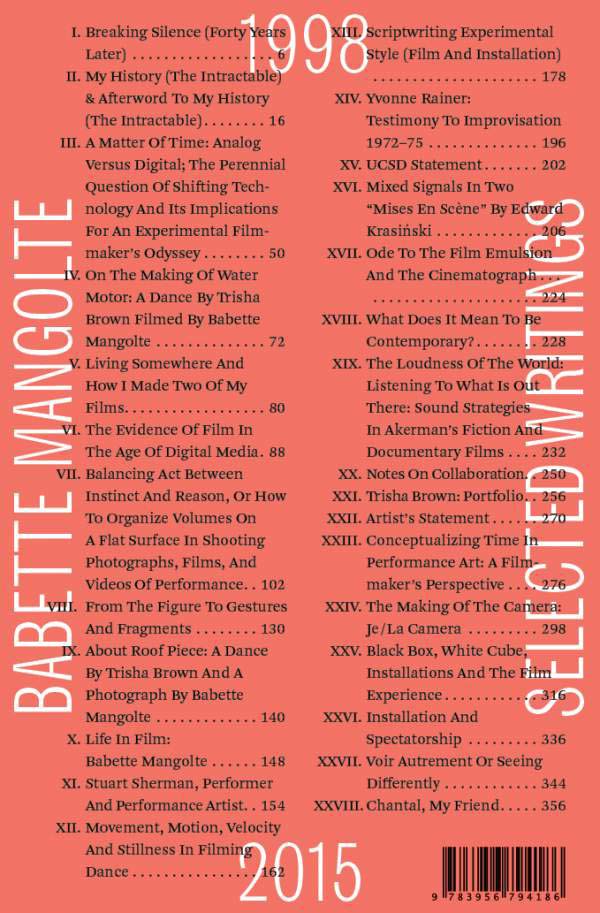
Selected Writings, 1998–2015
A single black-and white photograph taken by Babette Mangolte has come to epitomize New York’s downtown art scene of the 1970s. The dancers performing Trisha Brown’s Roof Piece characterize perfectly the wild spirit of the time. Choreographed as an echo of movement unfolding across SoHo’s rooftops, the dancers mimed the chimneys, water towers, and fire escapes which surrounded them across that skyline. Influenced early on by Dziga Vertov’s Man with a Movie Camera and the work of Stan Brakhage and Jonas Mekas, Mangolte began studies in 1964 at the renowned École nationale de la photographie et de la cinematographie in Paris, one of the school’s first female students. In 1970, having become disillusioned with the film scene in France, Mangolte moved to New York and became involved in the avant-garde film and dance milieus of the Kitchen and the Anthology Film Archives.
Selected Writings, 1998–2015 is a collection of texts by Mangolte in which she reflects on her practice as a photographer and filmmaker and her collaborative work with filmmakers, artists, dancers, and choreographers. She provides insights into the techniques and methods she created as well as her relationships with notable collaborators such as Marina Abramović, Chantal Akerman, Trisha Brown, and Yvonne Rainer.
Copublished with Kunsthalle Wien on the occasion of the exhibition “Babette Mangolte: I = Eye.”
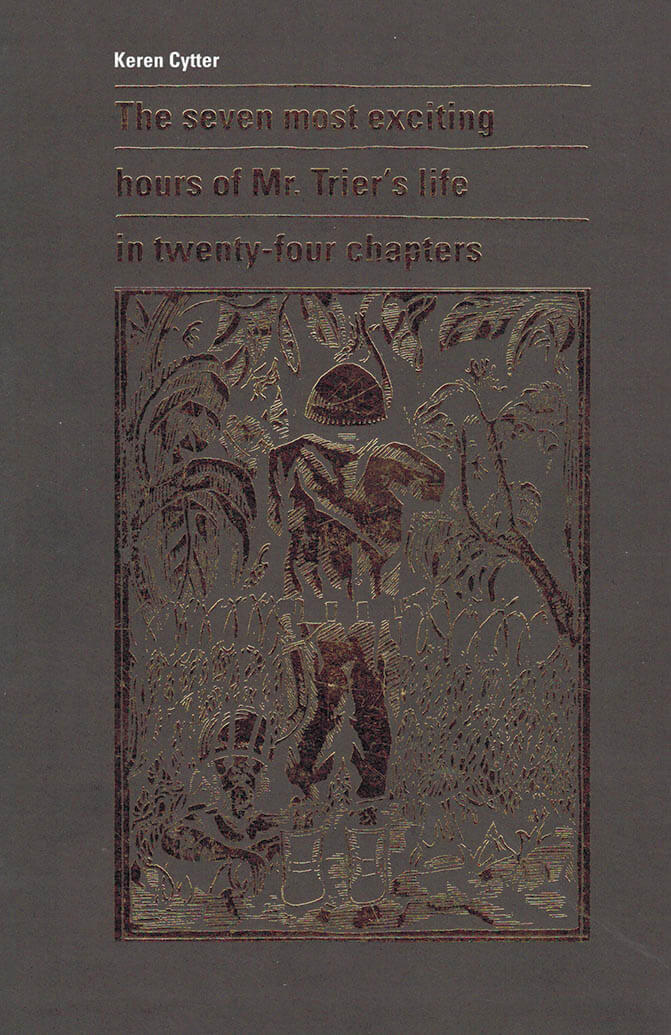
The seven most exciting hours of Mr. Trier's life in twenty-four chapters
An adventure novel based on a true story told in a televised interview by the Danish filmmaker Lars von Trier, describing seven hours in the life of Tibor Klaus Trier—Lars von Trier's father—from the moment that his wife goes into labor early in the morning until Lars is born.
The setting is Copenhagen, dominated by a hospital that recalls von Trier's television series “The Kingdom.” The plot is thick: Tibor arrives with his wife Margaret at the Maternity Ward of Mercy General Hospital, only to realize that he must return home to retrieve a forgotten mobile—his only link to a sister in distress. On the way, he stops to get gas and gets involved in a car robbery. A cancer takes root in his body. Back at home, he sneaks a peak at Margaret's e-mail and a great secret is revealed that makes him rush back to the hospital to kill her and her son. En route he crashes his new car and his body breaks into pieces and he loses his memory. Mercy General is haunted by a great ghost and the day is Armageddon when the ghost needs to challenge the living with an army of zombie children—all born within its walls. Who is this great ghost? What does Margaret hold in her body? Will Tibor survive his one day old cancer? All and more will be revealed…
Translated from the Hebrew by Hillel Roman.
Co-published with Witte de With.
Keren Cytter (born 1977 in Tel Aviv, lives and works in Amsterdam and Berlin) is an Israeli visual artist and filmaker.

A Long List Of Safe Words – (A.L.L.O.S.W)
A compilation of texts, poems and stories whose title is borrowed from the safe words used in BDSM practices.
Published on the occasion of the exhibition “Puberté 2”, Ravisius Textor, Nevers, from October 5 to November 16, 2019. Kevin Desbouis is a French artist and author.
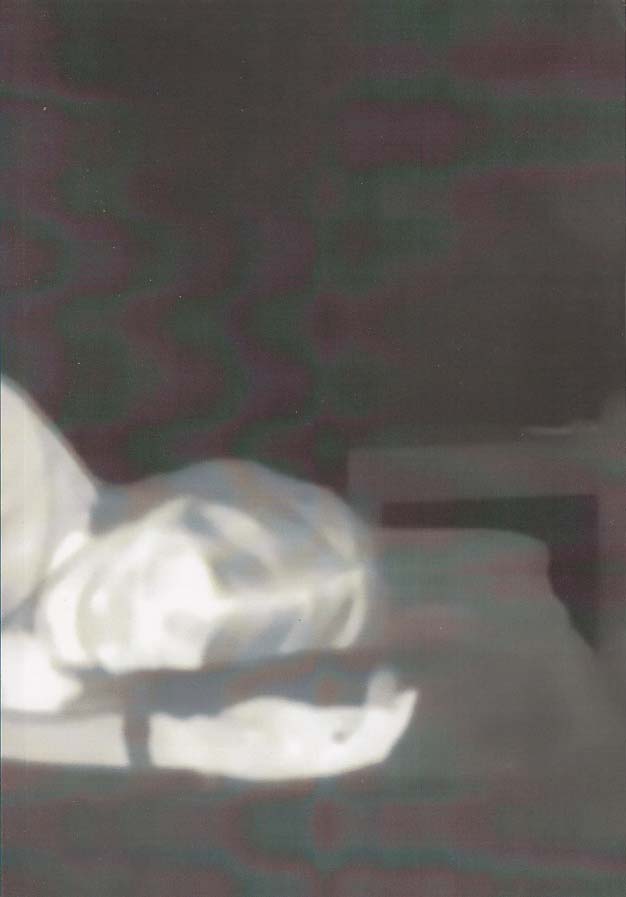
How to sleep faster 10
Winter 2019. SLEEP.
Contributions by: NAVILD ACOSTA, CLAY AD, MANDISA APENA, KHAIRANI BAROKKA, LINDA BESNER, LEAH CLEMENTS, PENNY GORING, LEWIS HAMMOND, ELAINE KAHN, GARETH DAMIAN MARTIN, LIV MENDEZ, BELLA MILROY, EILEEN MYLES, PRECIOUS OKOYOMON, LAUREN O’NEILL, RUTH PILSTON, HANNAH QUINLAN & ROSIE HASTINGS, FANNIE SOSA, ROMILY ALICE WALDEN, IAN WOOLDRIDGE and ANNA ZETT

If Our Wealth Is Criminal Then Let's Live with the Criminal Joy of Pirates
If Our Wealth Is Criminal Then Let's Live with the Criminal Joy of Pirates collects two short stories and an essay by Jacob Wren. In the first story, 'The Infiltrator, ' certain ongoing, rarely mentioned, difficulties for the activist Left are explored with unlikely candour. In 'Four Letters from an Ongoing Series, ' the postal service becomes an unwitting accomplice to the gatekeepers of potential culture. Finally, in the essay 'Like a Priest Who Has Lost Faith, ' questions of art and emptiness shift focus in relation to the agency that at all times surrounds us.

New Skin / Levitations
This book assembles the scripts of two solo performances levitations (2017) and New Skin (2018). Hannah De Meyer's work connects with the eco-feminist tradition and investigates the connections between femininity, ecology and decolonization. She merges text and movement into a quirky, hybrid theater language. Levitations is an enchanting trip along the peaks and valleys of De Meyers imagination. The recent new skin is an overwhelming feminist and ecological statement.

Typefaces don't care, typefaces do care
Jungmyung Lee, Charlie Clemoens
Real-Time Realist is a serial publication of J-LTF PRESS. This issue of Real-Time Realist explores Ecstasy, Joy, Serenity, and Love, The Yellow Wheel, with contributions from invited artists distilling the aforementioned emotions.
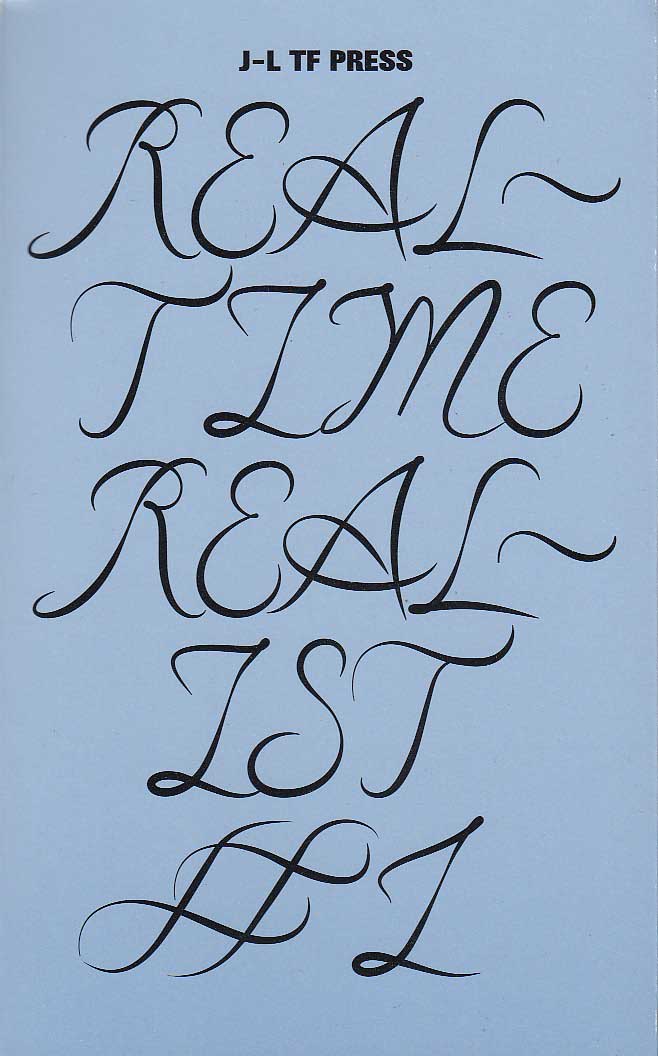
Typefaces have other interests besides words
Charlie Clemoens, Jungmyung Lee
This first issue of Real-Time Realist explores amazement, distraction, surprise and awe (the blue sector of Robert Plutchik's Wheel of Emotions) with contributions from invited artists distilling the aforementioned emotions. [publisher’s note.]
Real-Time Realist gathers contributions by graphic designers, writers, and artists, most of them living in the NL and former students of the Gerrit Rietveld Academie or the Werkplaats Typografie.
Contributors: Jungmyung Lee, Josse Pyl, Carson Lee, Charlie Clemoes, Laura Pappa, Lieven Lahaye, Will Pollard, Mathew Kneebone, Max Gershfield, Rudy Guedj.

Cookbook of Invisible Writing
A Cookbook of Invisible Writing, by Dutch artist, designer and teacher Amy Wu, is an introduction to analog steganography—a type of secret writing that is hidden in plain sight. This book serves as a starter pack to run workshops with groups who are interested in alternative forms of communication. It contains invisible ink recipes and other invisible communication techniques that may be used to subvert surveillance and bypass censorship, but also inspire your community to develop poetic and playful forms of communication to nurture social bonds. In the tradition of esoteric manuals published on secret writing, this cookbook also channels the spirit of everyday access and the easy distribution and sharing of practical knowledge.
Following Giambattista della Porta's 1558 popular science book Natural Magic—one of the first major publications that detailed simple but diverse recipes of invisible inks for public consumption—this cookbook aims to bring this obscure field to a wider audience. The publication includes a critical essay about the history of surveillance through a feminist and postcolonial lens. The last chapter presents Wu's own body of work that aims to revive analog techniques as a counter to today's digitally surveilled mediascape.

Théorie De L'Indiscernable
João Maria Gusmão, Pedro Paiva
Livret de 56 pages; format 13x21; illustré; couverture souple; cousu. Traduction originale du portugais ("Teoria do indiscernível" texte figurant dans le vol. "Abissologia - Teoria do Indiscernível", Lisboa - 2012). Édition bilingue portugais-français.
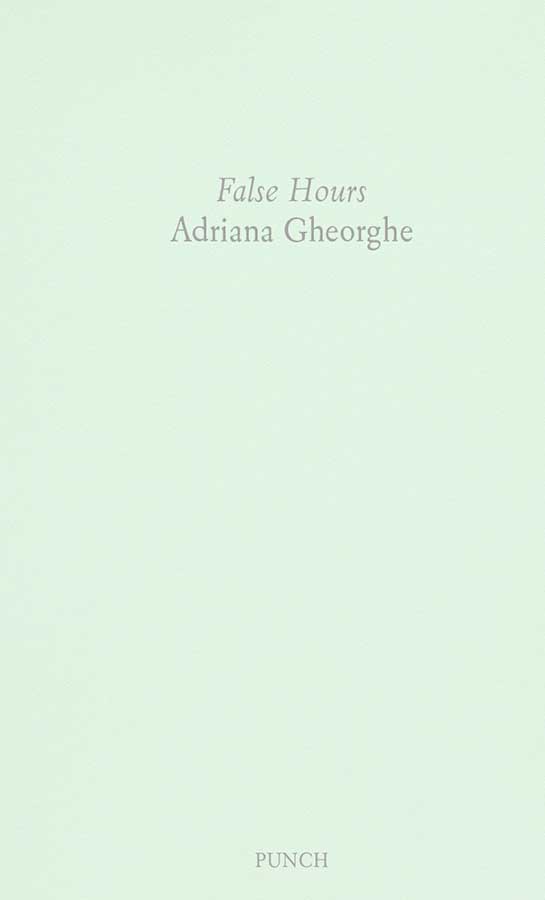
False Hours
Adriana Gheorghe works with performance and writing and a gravely irreverent sense of indeterminacy, while in relation to contexts (conceptual, physical, political, human), and for the reformulation of the same ongoing artistic and living practice – the performative imagining of the humans in relation to language and representation, hijacking subjectivity and identity with the crack of endless potentiality.

Square of Will in Square of Love
A collection of texts, notes and drawings from Alina Popa (1982-2019), edited as a tribute publication by her longtime accomplice, the artist Florin Flueras. A political and theoretical work that questioned both the intimate and social mechanisms of the contemporary.
Square of Will in Square of Love gathers a selection of texts, notes and drawings by Alina Popa, edited by Florin Flueras. Most texts are more poetic and more personal than Alina’s previously published writing, “...a mixture of styles, subjects and mediums—theory, poetry, drawings, diary notes, it's unclassifiable, as she liked it.” (Florin Flueras).
Alina Popa (1982-2019) was a Romanian artist who moved between choreography, theory, and contemporary art.
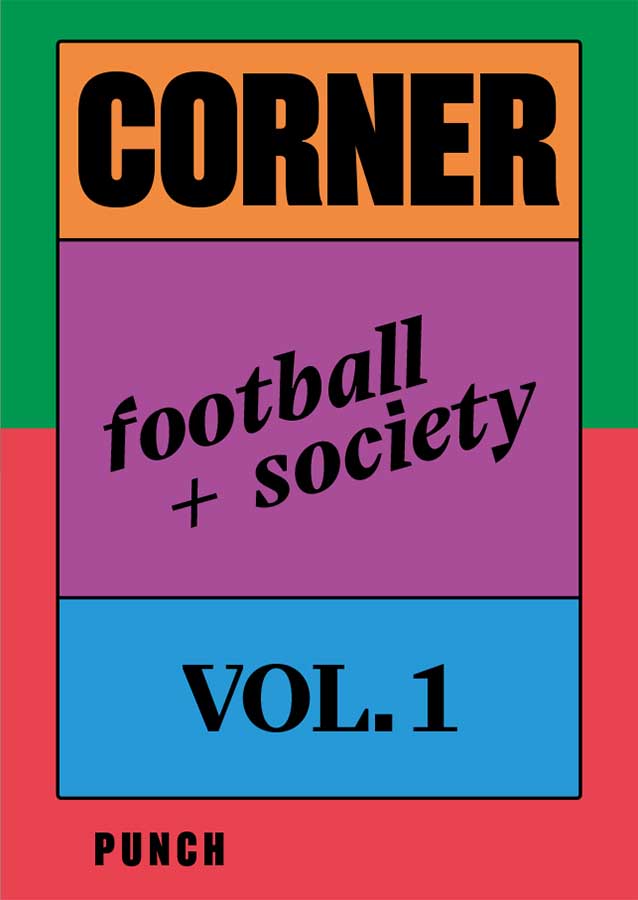
Corner Vol. 1
Paul Breazu, Raluca Voinea and 2 more
CORNER football+society VOL.1 comprises all contributions from the first six issues of the eponymous artist-run magazine, published in Romanian between 20015-2017.
With texts and conversations by: Mihnea Anţilă, Octav Avramescu, Violeta Beclea-Szekely, Matei Bejenaru, Declan Clarke, Irina Costache, Ion Dumitrescu, Florin Flueras, Bogdan Ghiu, Christopher Johnson, Cosima Opârtan, Florin Oprea, V. Leac, Andrei Mihail, Vasile Mihalache, Anca Verona Mihuleţ, Petrica Mogoş, James Montague, Cat Năstăsoiu, Pompiliu Nicolae-Constantin, Alexandra Pirici, Florin Poenaru, Ovidiu Pop, Powerpuff, Corneliu Porumboiu, Anamaria Pravicencu, Claudiu Revnic, Matei Sâmihaian, Ben Shave, Ştefan Tiron, Ovidiu Ţichindeleanu and artworks by: Enric Fort Ballester, Alex Bodea, Irina Botea + Jon Dean, Ion Grigorescu, Hortensia Mi Kafchin, Cătălin Mihalache, Monotremu, Dan Perjovschi, Alexandra Pirici & Jonas Lund, Raluca Popa, Gabriele de Santis, Sergiu Sas.
CORNER fotbal + societate is a periodical publication that proposes a crossdisciplinary approach, taking football and its complex contemporary and historical context as a starting point. This material foregrounds less (re)presented subjects and follows its evolution and social determinations. Aiming to intersect the culture of sport with various fields of knowledge such as anthropology, art, contemporary dance, architecture and economics, it follows less discussed aspects such as horizontal organisation, representation of minorities, gender power relations, subcultures and the relationship between the individual, group and society - amongst other topics. Under the current conditions, where both sport and art are being confiscated by the media and transformed into commodities, CORNER reclaims the democratic and emancipatory aspects of football, alongside a critical analysis of its functioning and reception modes.

Spread Wide
Rebecca Stevens, John Cussans and 2 more
Various artists and authors use two writers' correspondence as a primary source to develop an artistic and literary falsification. In this collaborative volume, the writer and artist Paul Buck works with the late 29 Kathy Acker. Using as source the raw materials of their correspondence from the early Eighties, a period when Acker was writing Great Expectations and trying to leave America for London, Buck confronts issues of appropriation, sampling, and plagiarism, relevant then and now.
Further encounters are triggered by writer Rebecca Stephens, artist John Cussans... and playwright Richard Foreman, artist Susan Hiller, musician David Coulter. Kathy Acker (1947-1997) was at the forefront of transgressive writing from the Seventies until her death. Her provocative intertextual narratives—halfway between autobiography and pornography—were developed in lectures, performances and films (Variety, Bette Gordon).
Her published work includes Blood and Guts in High School (1984), Don Quixote (1986), and Empire of the Senseless (1988). Rebecca Stephens escaped the chains of theology teaching to write on Saints and Courtesans, subjects on which books are in the pipeline.
John Cussans is a writer, artist and researcher who has exhibited regularly in London, Berlin, Slovenia, Vienna, Vancouver. In 2001 he founded The Bughouse, an art-event generator inspired by the work of Philip K. Dick. Paul Buck (born 1942, United Kingdom) is a British poet, performer and author of more than fifty crime novels. He has been challenging notions of writing, narrative, and the limits of the feasible since the late Sixties in books like The Honeymoon Killers, Violations and Lust, Walking into Myself... Chief editor of Curtains magazine, he introduced many French authors to the English audience.
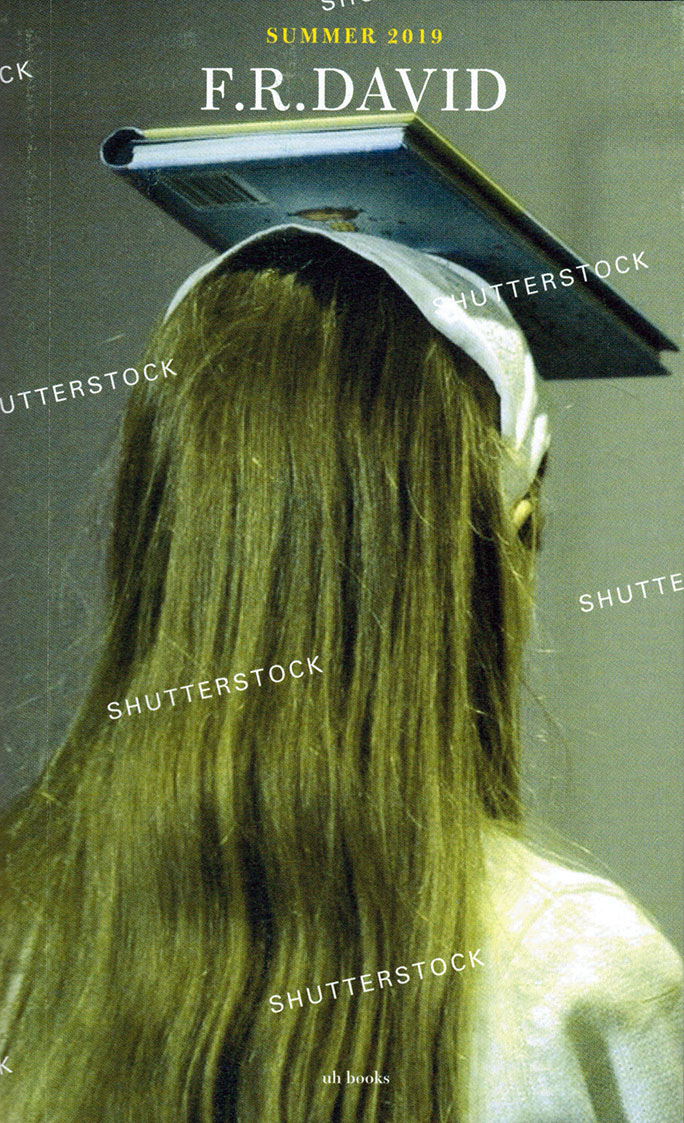
F.R. David - Recto Verso
F.R.DAVID is a typographical journal, dealing with the organisation of reading and writing in contemporary art practises. The 18th issue, “Recto Verso” is edited by Will Holder, and had its beginnings in prosody, the measure of language, geometry, and a notion of imagist transcription, even. A two-dimensional exercise, it turns out, on paper. Words were tuned out, in favour of the volume of values our bodies exchanged: “the historical and bodily movement of language amongst subjects.” Attentions turned—taking (the measure of) classes in body language: the non-verbal: the insinuated: the reverse-side of image: the backside, and, oddly: Oh no: we don’t speak about that—to the next page…